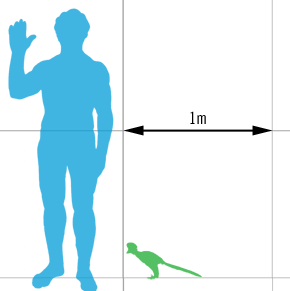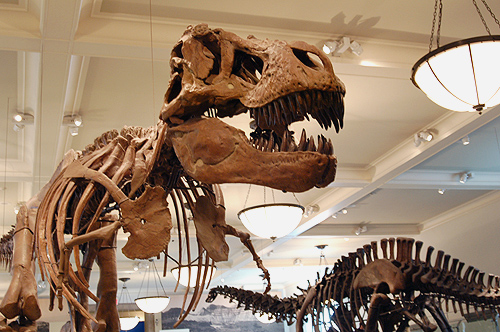|
Dinosaurs that existed prior to their supposed
transition into birds are called "non-avian" dinosaurs. Paleontologists have
identified over 500 distinct
genera and
more than 1,000 different species of non-avian dinosaurs. Dinosaurs are
represented on every continent by both
extant species and fossil remains. Some dinosaurs are or were
herbivorous, others carnivorous. Some have been
bipedal,
others
quadrupedal, and others have been able to shift between these body
postures. Many non-avian species developed elaborate skeletal modifications
such as
bony armor, horns or crests. Although generally known for the large size
of some species, most dinosaurs were human-sized or even smaller. Most
groups of dinosaurs are known to have built nests and laid eggs.
The term
"dinosaur" was coined in 1842 by the English paleontologist
Richard Owen, and
derives from Greek
δεινός (deinos)
"terrible, powerful, wondrous" +
σαῦρος
(sauros) "lizard".
Through the first half of the twentieth century, most of the scientific
community mistakenly believed dinosaurs to have been sluggish, unintelligent
cold-blooded animals.
Most
research conducted since the 1970s,
however, has indicated that dinosaurs were active animals with elevated
metabolisms and
numerous adaptations for social interaction.
Since the first dinosaur fossils were recognized
in the early nineteenth century, mounted dinosaur skeletons have been major
attractions at museums around the world, and dinosaurs have become a part of
world culture. They have been featured in best-selling books and films such
as
Jurassic Park, and new
discoveries are regularly covered by the media. The outdated image of
dinosaurs as maladapted extinct monsters has led to the word "dinosaur"
entering the
vernacular to describe
anything that is impractically large, slow-moving, obsolete, or bound for
extinction.
General Description
Dinosaurs
(aside from birds) can be generally described as terrestrial
archosaurian
reptiles with limbs
held erect beneath the body, that existed from the Late Triassic (first
appearing in the
Carnian faunal stage)
to the Late Cretaceous (going extinct at the end of the
Maastrichtian). Many
prehistoric animals are popularly conceived of as dinosaurs, such as
ichthyosaurs, mosasaurs, plesiosaurs, pterosaurs, and
Dimetrodon, but are not
classified scientifically as dinosaurs. Marine reptiles like ichthyosaurs,
mosasaurs, and plesiosaurs were neither terrestrial nor archosaurs;
pterosaurs were archosaurs but not terrestrial; and
Dimetrodon was a Permian
animal more closely related to mammals.
Dinosaurs were the dominant
terrestrial vertebrates of the Mesozoic, especially the Jurassic and
Cretaceous. Other groups of animals were restricted in size and niches;
mammals, for example, rarely exceeded the size of a cat, and were generally
rodent-sized carnivores of small prey.
Dinosaurs
were an extremely varied group of animals; according to a 2006 study, over
500 dinosaur genera have been identified with certainty so far, and the
total number of genera preserved in the fossil record has been estimated at
around 1850, nearly 75% of which remain to be discovered. As of September 17,
2008, 1047 different species of dinosaurs have been named. Some were
herbivorous, others carnivorous. Some dinosaurs were bipeds, some were
quadrupeds, and others, such as
Ammosaurus and
Iguanodon, could walk
just as easily on two or four legs. Dinosaur remains have been found on
every continent on Earth, including Antarctica. No dinosaurs are known to
have lived in marine or aerial habitats, although it is possible some
feathered theropods were flyers. There is also evidence that some
spinosaurids had
semi-aquatic habits.
Size
While the
evidence is incomplete, it is clear that, as a group, dinosaurs were large.
Even by dinosaur standards, the
sauropods were
gigantic. For much of the dinosaur era, the smallest sauropods were larger
than anything else in their habitat, and the largest were an
 |
| Scale diagram comparing the largest known dinosaurs in five
major
clades and a human (Click Picture for Larger View (Picture
Source) |
order of magnitude more
massive than anything else that has since walked the Earth. Giant
prehistoric
mammals such as the
Indricotherium and the
Columbian
mammoth were dwarfed by
the giant sauropods, and only a handful of modern aquatic animals approach
or surpass them in size – most notably the
blue whale, which
reaches up to
173,000
kg (381,000
lb) and over 30 meters (100 ft) in length. There are several proposed
advantages for the large size of sauropods, including protection from
predation, reduction of energy use, and longevity, but it may be that the
most important advantage was dietary. Large animals are more efficient at
digestion than small animals, because food spends more time in their
digestive systems. This also permits them to subsist on food with lower
nutritive value than smaller animals. Sauropod remains are mostly found in
rock formations
interpreted as dry or seasonally dry, and the ability to eat large
quantities of low-nutrient browse would have been advantageous in such
environments.
Most
dinosaurs, however, were much smaller than the giant sauropods. Current
evidence suggests that dinosaur average size varied throughout the time of
their existance. Theropod dinosaurs,
when sorted by estimated weight into categories based on
order of magnitude,
most often fall into the 100 to 1000 kilogram (220 to 2200 lb) category,
whereas recent predatory
carnivorans peak in the
10 to 100 kilogram (22 to 220 lb) category. The
mode of dinosaur body
masses is between one and ten metric tonnes. This contrasts sharply with the
size of
Cenozoic mammals,
estimated by the
National Museum of Natural History
as about 2 to 5 kilograms (5 to 10 lb).
Largest and Smallest
The tallest
and heaviest dinosaur known from good skeletons is
Giraffatitan brancai
(previously classified as a species of
Brachiosaurus). Its
remains were discovered in
Tanzania between
1907–12. Bones from multiple similar-sized individuals were incorporated
into the skeleton now mounted and on display at the Humboldt Museum of
Berlin; this mount is
12 meters (39 ft) tall and 22.5 meters (74 ft) long, and would have belonged
to an animal that weighed between
30,000
and 60,000 kilograms
(70,000
and 130,000 lbs).
The longest complete dinosaur is the 27-meter (89 ft) long
Diplodocus, which was
discovered in
Wyoming in the
United States and
displayed in Pittsburgh's
Carnegie Natural History Museum
in 1907.
There
were larger dinosaurs, but knowledge of them is based entirely on a small
number of fragmentary fossils. Most of the largest herbivorous specimens
on record were all discovered in the 1970s or later, and include the massive
Argentinosaurus, which
may have weighed
80,000
to 100,000 kilograms
(90 to 110 short tons); some of the longest were the 33.5 meters (110 ft)
long
Diplodocus hallorum
(formerly Seismosaurus)
and the 33 meters (110 ft) long
Supersaurus; and the
tallest, the 18 meters (59 ft) tall
Sauroposeidon, which
could have reached a sixth-floor window. The longest of them all may have
been
Amphicoelias fragillimus,
known only from a now lost partial vertebral
neural arch described
in 1878. Extrapolating from the illustration of this bone, the animal may
have been 58 meters (190 ft) long and weighed over
120,000
kg (260,000
lb). The largest known
carnivorous dinosaur
was
Spinosaurus, reaching
a length of 16 to 18 meters (50 to 60 ft), and weighing in at 8150 kg (18,000
lb). Other large meat-eaters included
Giganotosaurus,
Carcharodontosaurus
and
Tyrannosaurus.
 |
| The theropod Anchiornis in a scale drawing with a human (Picture
Source) |
Not
including modern birds, the smallest dinosaurs known were about the size of
a pigeon. The theropods
Anchiornis and
Epidexipteryx both had
a total skeletal length of under 35 centimeters (1.1 ft).
Anchiornis is currently
the smallest dinosaur described from an adult specimen, with an estimated
weight of 110 grams. The smallest herbivorous
dinosaurs included
Microceratus and
Wannanosaurus, at
about 60 cm (2 ft) long each
Creation Science and Dinosaurs (Optional)
Dinosaurs are very popular with young
earth creationists. This is because they are extinct, and they view
their extinction as a direct result of their belief in a global flood as
told in the story of Noah. As old earth creationists, we believe that
the flood of Noah was a local event, and that dinosaurs died 65 million
years ago, which is in agreement with all the scientific evidence. Understanding the young earth creationist claims is key to
being able to defend your beliefs.
Old Earth Ministries has a page
containing responses to young earth creationist claims, which can be found
at this link.
End of Reading

Return to the
Old Earth Ministries Online Earth
History Curriculum homepage.

Source Page:
Dinosaur
|


